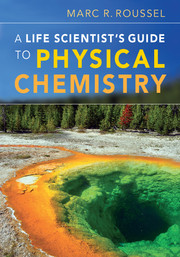Book contents
- Frontmatter
- Contents
- Preface
- 1 Orientation: what is physical chemistry about?
- Part One Quantum mechanics and spectroscopy
- Part Two Thermodynamics
- Part Three Kinetics
- 11 Basics of chemical kinetics
- 12 Initial rate experiments and simple empirical rate laws
- 13 Integrated rate laws
- 14 Complex reactions
- 15 Enzyme kinetics
- 16 Techniques for studying fast reactions
- 17 Factors that affect the rate constant
- 18 Diffusion and reactions in solution
- Appendix A Standard thermodynamic properties at 298.15 K and 1 bar
- Appendix B Standard reduction potentials at 298.15 K and 1 bar
- Appendix C Physical properties of water
- Appendix D The SI system of units
- Appendix E Universal constants and conversion factors
- Appendix F Periodic table of the elements, with molar masses
- Appendix G Selected isotopic masses and abundances
- Appendix H Properties of exponentials and logarithmic functions
- Appendix I Review of integral calculus
- Appendix J End-of-term review problems
- Appendix K Answers to exercises
- Index
18 - Diffusion and reactions in solution
from Part Three - Kinetics
Published online by Cambridge University Press: 05 June 2012
- Frontmatter
- Contents
- Preface
- 1 Orientation: what is physical chemistry about?
- Part One Quantum mechanics and spectroscopy
- Part Two Thermodynamics
- Part Three Kinetics
- 11 Basics of chemical kinetics
- 12 Initial rate experiments and simple empirical rate laws
- 13 Integrated rate laws
- 14 Complex reactions
- 15 Enzyme kinetics
- 16 Techniques for studying fast reactions
- 17 Factors that affect the rate constant
- 18 Diffusion and reactions in solution
- Appendix A Standard thermodynamic properties at 298.15 K and 1 bar
- Appendix B Standard reduction potentials at 298.15 K and 1 bar
- Appendix C Physical properties of water
- Appendix D The SI system of units
- Appendix E Universal constants and conversion factors
- Appendix F Periodic table of the elements, with molar masses
- Appendix G Selected isotopic masses and abundances
- Appendix H Properties of exponentials and logarithmic functions
- Appendix I Review of integral calculus
- Appendix J End-of-term review problems
- Appendix K Answers to exercises
- Index
Summary
A bimolecular elementary reaction requires that the two reactants meet. In solution, molecules are constantly bumping into other molecules, with the net effect that they wander randomly through the solution, which we call diffusion. In this chapter, we will study diffusion and its effect on chemical reactions, specifically focusing on the rate at which molecules meet each other. This will give us an upper bound on the reaction rate, which is useful for a number of purposes.
Diffusion
A molecule in solution is constantly surrounded by other molecules. All the molecules are constantly bumping into their neighbors. They move around the solution by sliding between their neighbors, much as you might slide between people tomake your way around a crowded room. This process is a form of diffusion, the random motion of molecules in space.
The central quantity in describing diffusion is the flux, which is the rate at which molecules cross an imaginary surface in space per unit area of this surface. The flux therefore has units of number per unit time per unit area (e.g. mol s-1 m-2). We're going to focus on diffusion in one dimension, where it's a little easier to picture what is going on. Imagine that we have a tube of cross-sectional area A. The tube is narrow enough that we can treat the concentration across the tube as being constant.
- Type
- Chapter
- Information
- A Life Scientist's Guide to Physical Chemistry , pp. 359 - 374Publisher: Cambridge University PressPrint publication year: 2012



